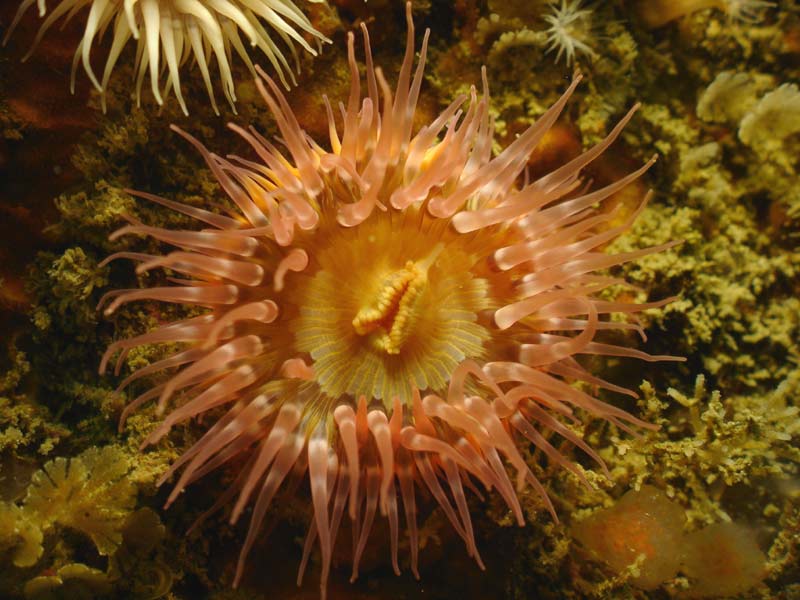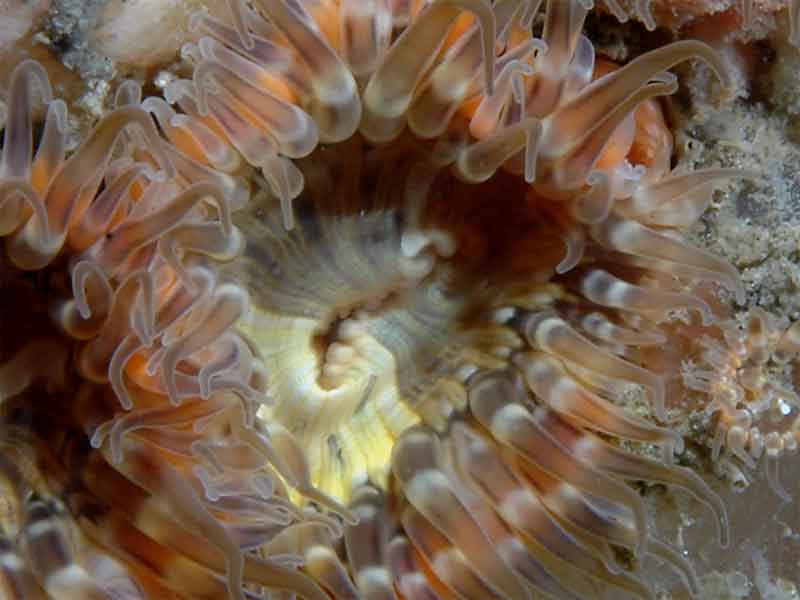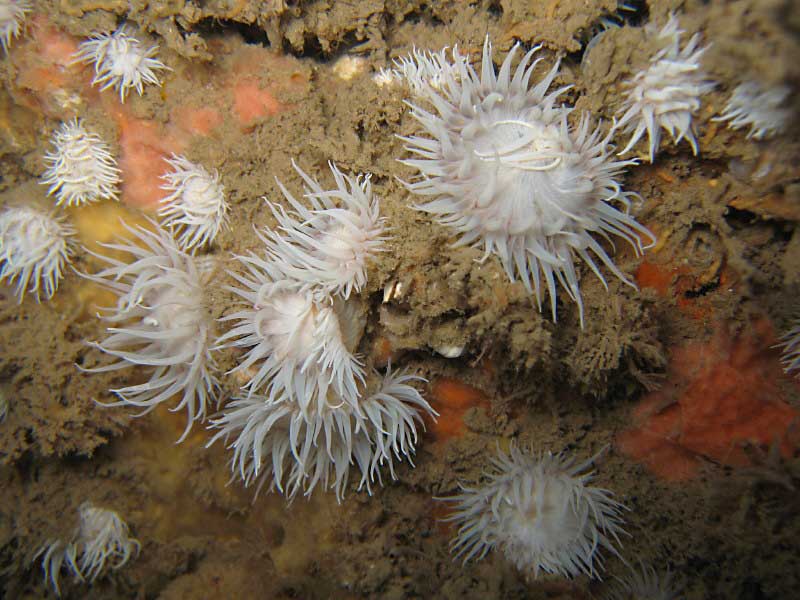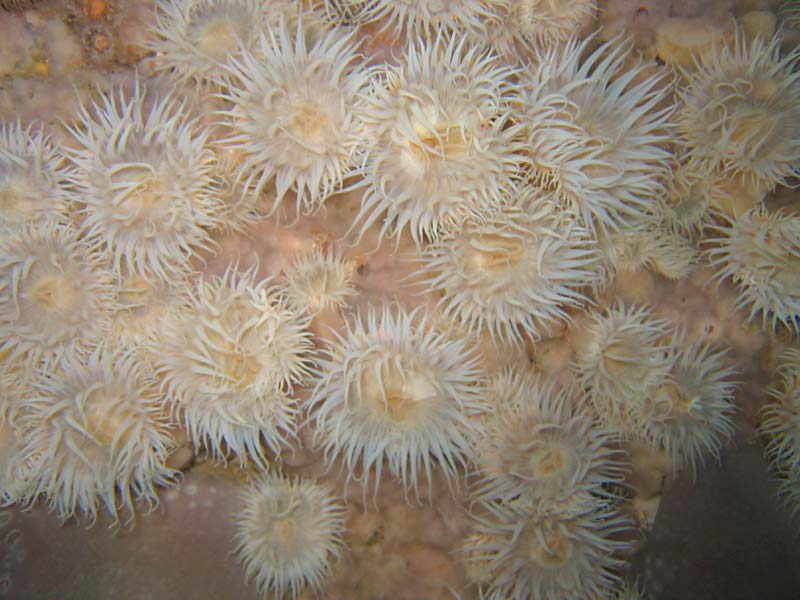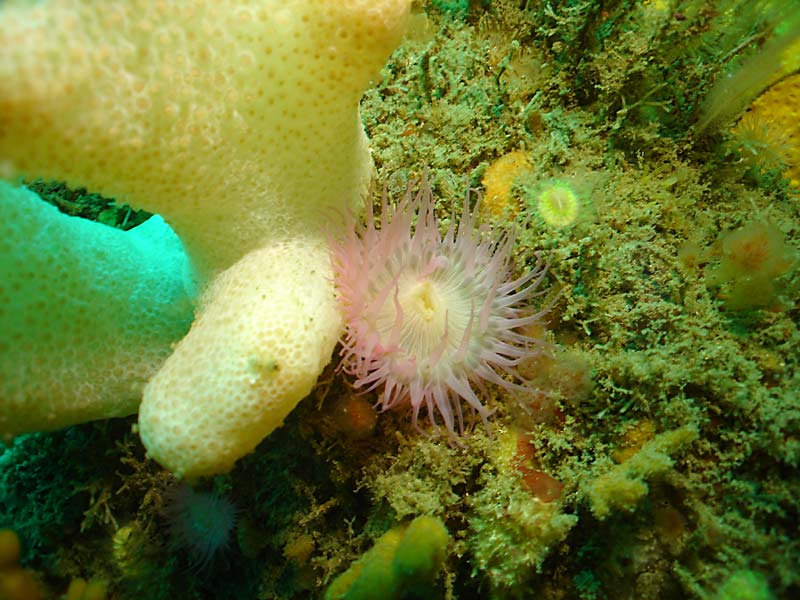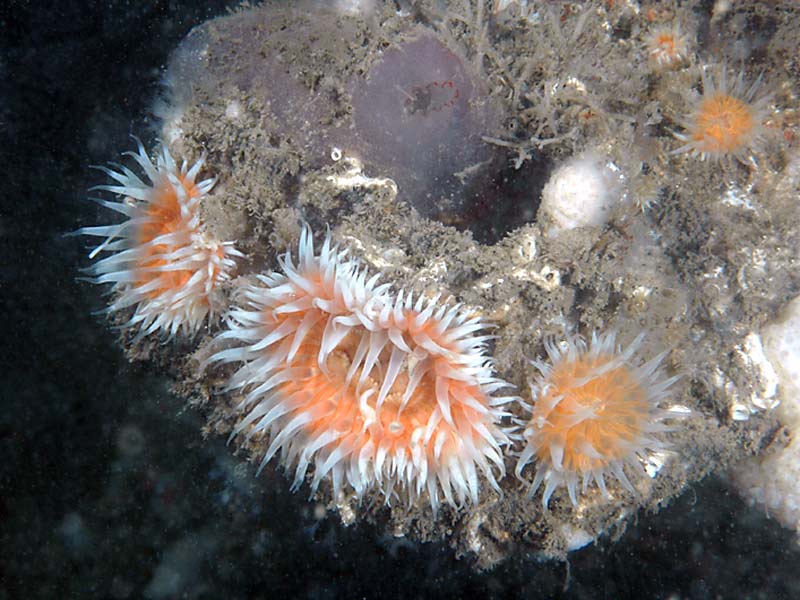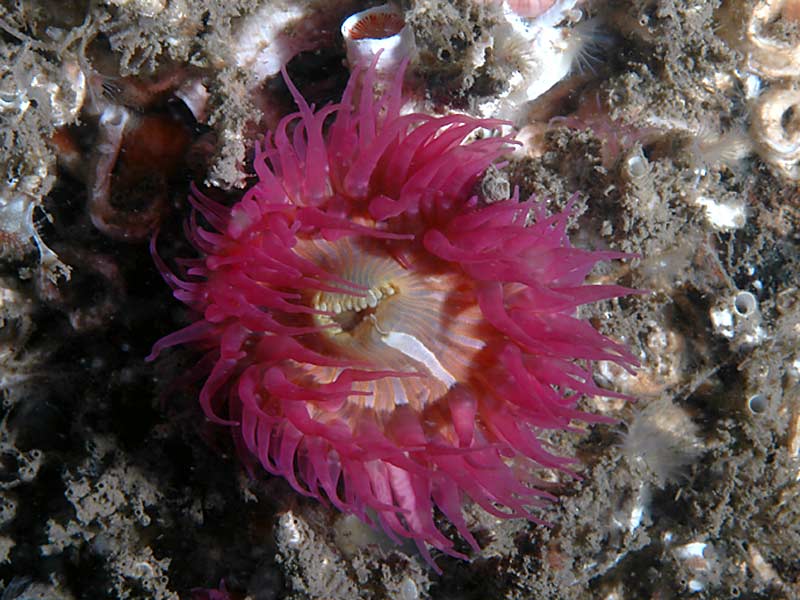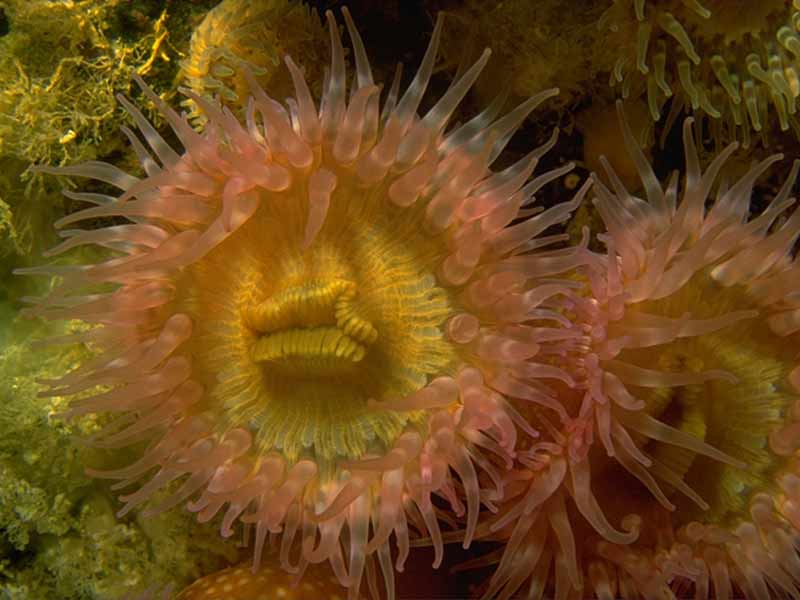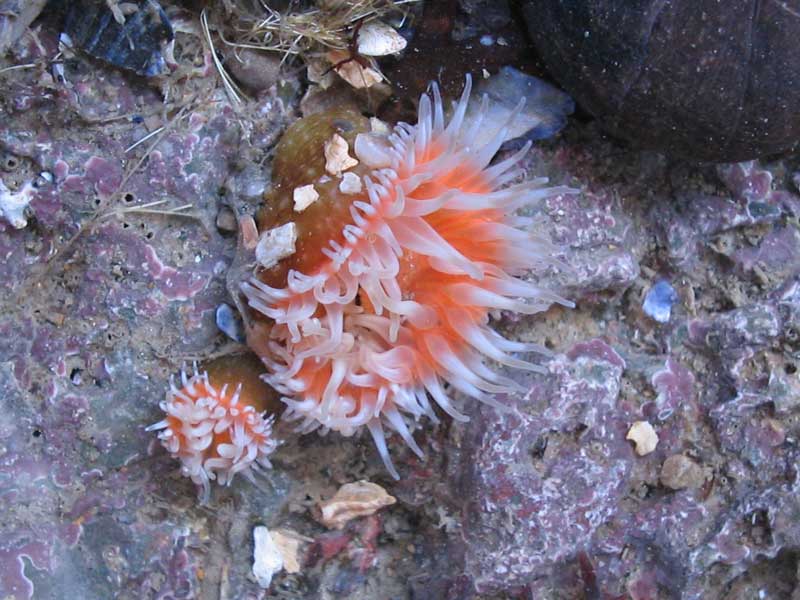Elegant sea anemone (Cylista elegans)
Distribution data supplied by the Ocean Biodiversity Information System (OBIS). To interrogate UK data visit the NBN Atlas.Map Help
| Researched by | Frances Peckett | Refereed by | Admin |
| Authority | (Dalyell, 1848) | ||
| Other common names | - | Synonyms | Sagartia rhododactylus , Sagartia elegans (Dalyell, 1848) |
Summary
Description
Cylista elegans is a very variable species (see additional information), all varieties have a base up to 30 mm and this is wider than the column and closely adherent. The column is moderately tall and flares out towards the disk. The upper part of the column is has numerous white suckers which appear as white spots and cinclides (small pores) just visible as dark spots. Acontia (white defence threads) are freely emitted from cinclides when the anemone disturbed. The tentacles are moderate to long and there are approximately 200 of them spanning about 4 cm. . This species is often found in large aggregations and may live with their bases inside a hole in the substratum into which they retract into when disturbed. The colour of the column is variable; red, orange, brown whitish or greenish.
Recorded distribution in Britain and Ireland
Common or locally abundant on all coasts of Britain and Ireland.Global distribution
Recorded from south-west Europe to the Mediterranean and also north to Iceland and Scandinavia.Habitat
This sea anemones found on shore in pools, under stones, caves and beneath overhangs, from the mid-tide level and below. This species is also common in the sublittoral down to approximately 50 m.Depth range
-Identifying features
- Base up to 30 mm in diameter.
- Base wider than the column and strongly adherent.
- Column moderately tall and flares out to disc.
- Columns varies in colour: red, orange, brown, whitish or pale grey-green.
- Numerous suckers appear as white spots on column.
- Cinclides, (small pores) just visible as dark spots on upper part of column.
- Tentacles moderately long and about 200 spanning 4 cm.
Additional information
The taxonomy of the family Sagartiidae was recently examined by Sanamyan & Sanamyan (2020) who concluded that the genus Sagartia was not valid and should be assigned to the genus Cylista. There are 5 different varieties of the species recognised on the basis of the colouration of the disc and tentacles.
- Var. miniata - the colour of the disc is variable, often variegated in - orange, red, brown, cream, grey etc. The disc is always marked with a dark pattern. The tentacles are similar to the disc, always banded and may have longitudinal lines.
- Var. rosea - the disc is variably coloured, plain or patterned as in miniata with the tentacles being pink, rose-red or magenta.
- Var. aurantiaca - the disc is greyish, sometimes patterned and tentacles are a dull orange.
- Var.venusta - the disc is a plain orange and the tentacles are white.
- Var. nivea - disc and tentacles white.
Listed by
- none -
Bibliography
Hayward, P.J. & Ryland, J.S. (ed.) 1995b. Handbook of the marine fauna of North-West Europe. Oxford: Oxford University Press.
Howson, C.M. & Picton, B.E., 1997. The species directory of the marine fauna and flora of the British Isles and surrounding seas. Belfast: Ulster Museum. [Ulster Museum publication, no. 276.]
Manuel, R.L., 1988. British Anthozoa. Synopses of the British Fauna (New Series) (ed. D.M. Kermack & R.S.K. Barnes). The Linnean Society of London [Synopses of the British Fauna No. 18.]. DOI https://doi.org/10.1002/iroh.19810660505
Picton, B.E. & Costello, M.J., 1998. BioMar biotope viewer: a guide to marine habitats, fauna and flora of Britain and Ireland. [CD-ROM] Environmental Sciences Unit, Trinity College, Dublin.
Sanamyan, K. & Sanamyan, N., 2020. Comments on the nomenclatural status and validity of several family-series nomina in Actiniaria (Cnidaria, Anthozoa). Bionomina, 19 (1), 100-109. DOI https://doi.org/10.11646/bionomina.19.1.6
Stephenson, T.A., 1935. The British Sea Anemones, vol. 2. London: Ray Society.
Datasets
Centre for Environmental Data and Recording, 2018. Ulster Museum Marine Surveys of Northern Ireland Coastal Waters. Occurrence dataset https://www.nmni.com/CEDaR/CEDaR-Centre-for-Environmental-Data-and-Recording.aspx accessed via NBNAtlas.org on 2018-09-25.
Environmental Records Information Centre North East, 2018. ERIC NE Combined dataset to 2017. Occurrence dataset: http://www.ericnortheast.org.ukl accessed via NBNAtlas.org on 2018-09-38
Fenwick, 2018. Aphotomarine. Occurrence dataset http://www.aphotomarine.com/index.html Accessed via NBNAtlas.org on 2018-10-01
Fife Nature Records Centre, 2018. St Andrews BioBlitz 2016. Occurrence dataset: https://doi.org/10.15468/146yiz accessed via GBIF.org on 2018-09-27.
Isle of Wight Local Records Centre, 2017. IOW Natural History & Archaeological Society Marine Invertebrate Records 1853- 2011. Occurrence dataset: https://doi.org/10.15468/d9amhg accessed via GBIF.org on 2018-09-27.
Kent Wildlife Trust, 2018. Kent Wildlife Trust Shoresearch Intertidal Survey 2004 onwards. Occurrence dataset: https://www.kentwildlifetrust.org.uk/ accessed via NBNAtlas.org on 2018-10-01.
Lancashire Environment Record Network, 2018. LERN Records. Occurrence dataset: https://doi.org/10.15468/esxc9a accessed via GBIF.org on 2018-10-01.
Manx Biological Recording Partnership, 2017. Isle of Man wildlife records from 01/01/2000 to 13/02/2017. Occurrence dataset: https://doi.org/10.15468/mopwow accessed via GBIF.org on 2018-10-01.
Manx Biological Recording Partnership, 2022. Isle of Man historical wildlife records 1990 to 1994. Occurrence dataset:https://doi.org/10.15468/aru16v accessed via GBIF.org on 2024-09-27.
Merseyside BioBank., 2018. Merseyside BioBank (unverified). Occurrence dataset: https://doi.org/10.15468/iou2ld accessed via GBIF.org on 2018-10-01.
NBN (National Biodiversity Network) Atlas. Available from: https://www.nbnatlas.org.
Norfolk Biodiversity Information Service, 2017. NBIS Records to December 2016. Occurrence dataset: https://doi.org/10.15468/jca5lo accessed via GBIF.org on 2018-10-01.
North East Scotland Biological Records Centre, 2017. NE Scotland other invertebrate records 1800-2010. Occurrence dataset: https://doi.org/10.15468/ifjfxz accessed via GBIF.org on 2018-10-01.
OBIS (Ocean Biodiversity Information System), 2025. Global map of species distribution using gridded data. Available from: Ocean Biogeographic Information System. www.iobis.org. Accessed: 2025-08-08
South East Wales Biodiversity Records Centre, 2023. SEWBReC Marine and other Aquatic Invertebrates (South East Wales). Occurrence dataset:https://doi.org/10.15468/zxy1n6 accessed via GBIF.org on 2024-09-27.
Citation
This review can be cited as:
Last Updated: 23/09/2021

